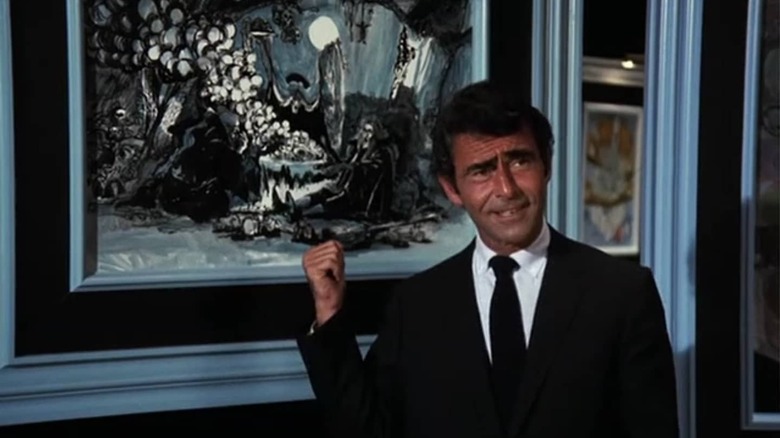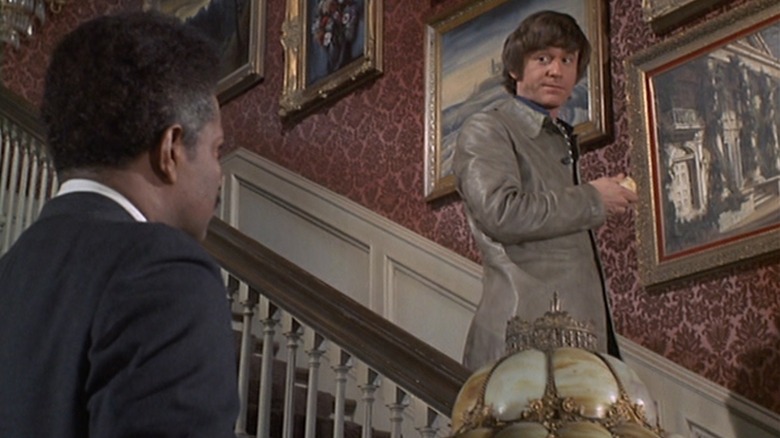Commission may be earned from purchases made through the links provided.
NBC
Even today, “The Twilight Zone,” a sci-fi anthology series by Rod Serling, is often cited as one of the greatest TV shows ever. The series, which was developed by Serling and a group of top sci-fi writers from the 50s and 60s, consisted of 156 short morality tales, typically with a supernatural twist. This innovative approach to storytelling, which proved that a complete morality tale could be told in just 25 minutes (or 51 minutes in the fourth season), revolutionized television. Furthermore, Serling made sure that every episode contained a clear moral, making “The Twilight Zone” a powerful tool for social commentary.
“The Twilight Zone” aired for five seasons from 1959 to 1964, with a total of 156 episodes. The show was syndicated, allowing generations of children to rewatch old episodes well into the 90s. Some TV channels in the US even hosted annual “Twilight Zone” marathons on Thanksgiving Day, turning Serling’s series into a cultural institution. Today, young people can still reference a creature on an airplane wing or that “To Serve Man” is a cookbook.
After “The Twilight Zone,” Serling struggled to replicate his success. He created a short-lived Western called “The Loner” in 1965, but it only lasted one season. In 1969, Serling wrote an international version of “A Christmas Carol” titled “A Carol for Another Christmas” featuring Peter Sellers. That same year, Serling hosted the game show “Liar’s Club,” which he left after 21 episodes.
Serling’s return to anthology horror, while well-remembered by fans, was fraught with production difficulties. Classic TV enthusiasts will be familiar with “Night Gallery,” which premiered in 1969.
‘Night Gallery’: A More Horror-Driven Version of ‘The Twilight Zone’

NBC
“Night Gallery” was an anthology series that started and ended with a unique twist. At the start of each episode, Serling would appear in a vast, wall-less art gallery filled with eerie, macabre paintings. He would wander around the museum, seemingly after closing time, guiding viewers towards various artworks. He would then explain that each painting was inspired by the chilling tale he was about to tell. Artists Thomas J. Wright and Jerry Gebr provided the paintings.
“Night Gallery” can be seen as a spiritual successor to “The Twilight Zone,” as it shared a similar tone and told equally engaging stories. “Night Gallery” distinguished itself with its focus on supernatural evil and its stunning color photography. Like “The Twilight Zone,” “Night Gallery” sourced stories from sci-fi magazines and literary anthologies, featuring TV adaptations of stories by Richard Matheson, H.P. Lovecraft (including “Cool Air” and “Pickman’s Model”), and many others. NBC wanted a deliberately gruesome series, and Serling was more than willing to comply, as long as he could continue to incorporate morals and social commentary into his episodes.
Just like “The Twilight Zone,” “Night Gallery” showcased an impressive array of talent. The series provided some early directing opportunities for a young Steven Spielberg, and actor John Astin directed a story, as did Leonard Nimoy. Jeannot Swarc directed many episodes, as did future “Saturday Night Fever” director John Badham. Serling wrote most of the “Night Gallery” episodes. Guest stars included Vincent Price, Burgess Meredith, Stuart Whitman, Cameron Mitchell, Leslie Nielsen, John Saxon, Joan Crawford (in her final acting role), Orson Welles, Phyllis Diller, and many others.
Rod Serling and His Producer, Jack Laird, Often Clashed

NBC
“Night Gallery” was initially presented as a Wheel Show, meaning it was one of several shows that would rotate in the same weekly timeslot. The show shared its slot with “McCloud,” “The Psychiatrist,” and “San Francisco International Airport,” with all four shows bundled together as “Four in One.” As a result, the first season of “Night Gallery” only had six episodes.
However, problems arose starting in the second season. The show’s producer, Jack Laird, rejected many of Serling’s scripts and began insisting on adding his own comedic interludes between the macabre tales. Serling despised these “blackout sketches,” stating in the biography “Rod Serling: His Life, Work, and Imagination,” that “I thought they distorted the thread of what we were trying to do on ‘Night Gallery.’ I don’t think one can show Edgar Allan Poe and then come back with Flip Wilson for 34 seconds. I just don’t think they fit.” Flip Wilson was a popular comedian in the early 1970s.
During the show’s second season, Serling resigned as executive producer to focus on writing full-time. Unfortunately, this resulted in him having less creative control, and the quality of “Night Gallery” began to decline. By the third season, the series was cut down to a 30-minute format, and Laird started insisting on fewer morality tales like those on “The Twilight Zone.” There was also a directive to adapt fewer European short stories and more American ones. The series was canceled after its third season, having run for 43 episodes.
However, “Night Gallery” was not forgotten. It was popular enough to be parodied in “The Simpsons'” fourth Halloween Special. Spielberg also remembered his roots and reused the title as “Night Ghoulery” for the “Tiny Toon Adventures” Halloween Special he produced. While “Night Gallery” may not have the same cultural impact as “The Twilight Zone,” a search through the episodes will reveal a few stories that are just as good, if not better. The series can be purchased on Prime Video.
FAQs
Q: How long did “The Twilight Zone” run for?
A: “The Twilight Zone” aired for five seasons from 1959 to 1964, with a total of 156 episodes.
Q: What was unique about “Night Gallery”?
A: “Night Gallery” was unique in its focus on supernatural evil and its use of stunning color photography. It also distinguished itself by having Serling present each episode in a vast, wall-less art gallery filled with eerie, macabre paintings.
Q: Why did “Night Gallery” decline in quality?
A: The quality of “Night Gallery” declined when Serling resigned as executive producer to focus on writing full-time, resulting in him having less creative control. The show’s producer, Jack Laird, also started rejecting many of Serling’s scripts and began insisting on adding his own comedic interludes between the macabre tales.
Q: How many episodes of “Night Gallery” were there?
A: “Night Gallery” ran for three seasons, with a total of 43 episodes.
Credit: www.slashfilm.com


